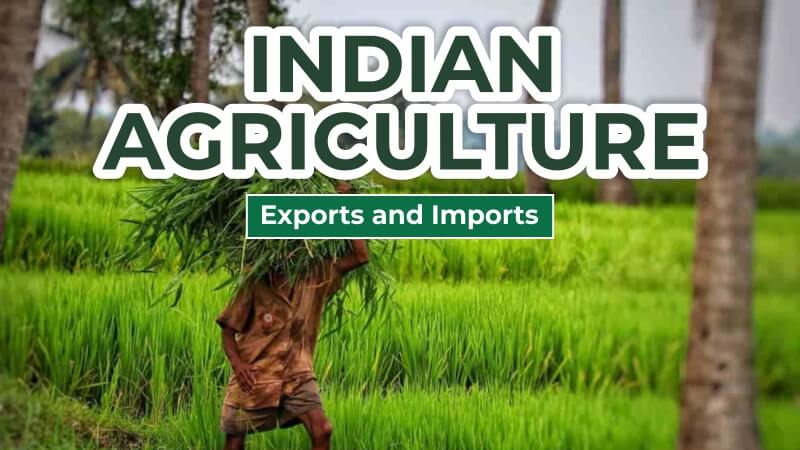India has an agrarian economy, with over 54% of the country’s land classified as arable and 50% of the labor force working in industries related to agriculture. India ranks among the top producers of a number of commodities, including rice, wheat, cotton, sugar, horticulture, and dairy. 19.9% of the nation’s GDP is made up of the agricultural sector and industries that are closely related, such as forestry and fishing. As a result, the agriculture industry is crucial to Indian politics, economy, and society.
The monsoon (seasonal rainfall) heavily influences India’s agricultural output of staple foods, and farm yields are typically below average globally. Numerous factors contribute to low productivity, including inadequate farmer education and training, strict government regulation, an ineffective food distribution system, poor infrastructure, unpredictable weather, small average farm sizes, and domestic agriculture support programs and subsidies that distort market signals and discourage investment.
Indian Agricultural Export:
India exports three types of agricultural goods:
a) raw items; b) semi-raw products; and c) processed goods. and items that are ready to eat. Raw materials essentially, exports are of low value, and high volume, whereas semi-processed goods are of small volume and moderate worth. and prepared foods that have been processed are of high modest volume yet high value.
Cereals (mostly rice, both Basmati and non-Basmati), spices, cashew, oilcake/meals, tobacco, tea, and coffee are among India’s top agricultural exports, along with marine items. Between 15% and 20% of the nation’s overall exports are made up of agricultural products.
Conflicting internal rules regarding production, storage, distribution, food security, pricing issues, etc. place certain restrictions on India’s agri-exports.
Indian supply sources are unreliable because they are unwilling to decide on fundamental minimum export volumes. Our exports are less competitive in the market due to higher domestic pricing for products that are exported in large quantities, such as sugar, wheat, and rice.
To increase agricultural exports, market research and raising consumer awareness of product quality must be increased.
Indian Agriculture Imports:
Conflicting internal rules regarding production, storage, distribution, food security, pricing issues, etc. place certain restrictions on India’s agri-exports in agriculture.
Indian supply sources are unreliable because they are unwilling to decide on fundamental minimum export volumes. Our exports are less competitive in the market due to higher domestic pricing for products that are exported in large quantities, such as sugar, wheat, and rice.
To increase agricultural exports, market research and raising consumer awareness of product quality must be increased. Raw cashew nuts are another commodity that has been making up about 10% of all agricultural imports.
The general rule is that import taxes should be minimal for those delicate necessary goods where domestic manufacturing is severely lacking. A classic example of a product with no import taxes is pulses. Many agricultural and related products, including rice, wheat, millet, sugar, milk powder, apples, poultry, and edible oils, have high tariff walls this year because of concerns of widespread import policy liberalization resulting in the dumping of these products on the Indian market.
The agricultural industry is gradually moving away from traditional farming and toward the production of horticulture and livestock (poultry, dairy, and fisheries). As the population urbanizes, earnings grow, and consumption habits change, the demand for fresh and processed goods of all kinds is rising. From “farm to fork,” the development of an effective cold chain network will help reduce the rate of agricultural output deterioration while assisting farmers in capturing value as products maintain quality and provide customers with more advantages.
One of the fastest increasing categories of agricultural imports, consumer-oriented food imports, with tree nuts and fresh fruit as the two main contributors, reached more in 2020. The middle class is steadily expanding, the population, wealthy professionals, brand-focused imports, and contemporary lifestyles have all contributed to this growth.
Leading exports and imports of agricultural products list are listed below:
- Seasonings and sauces
In 2020, India imported condiments and sauces, which came from the United States. Thailand, China, Malaysia, the UAE, and several European nations also contributed sizable supply. As consumers and restaurants experiment with these imported items, retail and restaurant sector options are expanding, and demand for imported seasoning and sauces is rising.
- Cotton
One of the biggest producers and exporters of cotton worldwide is India. Nevertheless, India will keep importing high-quality long staple and extra-long staple (ELS) cotton, as well as medium staple cotton on occasion when global prices are good. The Indian government increased the cost for textile exporters who utilize imported cotton for yarn, clothing, and home textile products. However, exports of ELS cotton are anticipated to stay consistent due to the solid demand outlook in export markets. Over the past few years, cotton has been one of India’s top imports from the United States.
- Fresh Fruits
The majority of fresh fruits have market access in India. There is a rising demand for imported fresh fruits as a growing sector of customers insists on high-quality standards and year-round availability. The value of U.S. fresh fruit imports into India in 2020 was a million, with apples accounting for the largest market share. These imports included, but were not limited to, apples, pears, cherries, and blueberries.
The increased demand for blueberries is also a result of increased consumer awareness of the fruit’s health advantages, as well as its adaptability and use as a value-added component in a variety of goods.
Pulses
With annual imports expected to reach maximum, India is the world’s largest producer, consumer, and importer of pulses (peas, lentils, and beans). A record of tonnes of imports was made in 2017, primarily from Canada, Myanmar, Australia, Russia, China, and the United States. The Government of India has since then implemented a number of measures to limit the imports of pulses.
Snack Foods
Despite greater competition from domestic suppliers, changing consumer lifestyles and rising disposable income levels are driving up demand for imported snack items.
Agricultural Machinery
The tractor market in India is the biggest in the world. Approximately 35% of the world’s tractor production is produced in India. The typical agricultural size in India is less than three acres, hence tractor usage is limited when compared to other advanced economies.
Food Processing and Packaging
India is the world’s largest producer of various commodities and is the second-largest exporter of food in the world. Only a little proportion of products is processed in India, nevertheless. Due to a lack of innovative processing technologies and inadequate supply chain infrastructure, less than 10% of its perishable food gets processed.
To get the latest updates on the tractor, tractor price, and tractor news install the KhetiGaadi application.




